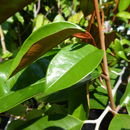Comprehensive Description
provided by Smithsonian Contributions to Botany
Chrysophyllum cainito L
Chrysophyllum cainito L., Sp. Pl. 192. 1753.—Pancher in Cuzent, Iles Soc. Tahiti. 234. 1860.—Lanessan, Pl. Ut. Col. Franc. 865. 1886.—Butteaud, Fl. Tahiti. 56. 1891.—Wilder, Bish. Mus. Bull. 86:86. 1931.—Christophersen, Bish. Mus. Bull. 128:171. 1935.
DESCRIPTION.—Striking tree with twigs and leaves (below) shining reddish brown pubescent. Blades elliptical, 7–10 × 4–4.5 cm, coriaceous, lucid above. Flowers small, in sessile, axillary fascicles. Fruit globose, 5–10 cm, in diameter, 7–10-celled, purple.
RANGE.—Society Islands (cultivated): Tahiti: Brown 1196, alt. 60 m (200 ft), 17 October 1922, sterile (BISH); Grant 4310, Papeete, alt. 6 m, 22 October 1930, flower (BISH, MIN). Raiatea: Moore 697, Huaru, alt. 1 m, 31 March 1927 (BISH, 2 sheets; MIN).
Native to the West Indies. Introduced into Tahiti in 1852 by Admiral Bruat, according to Pancher. Previously reported from Rarotonga (!) and Samoa. Also cultivated in Hawaii and in Fiji (Gillespie 4637, Taviuni, BISH).
LOCAL NAMES.—English: star-apple, from the shape of the “core.” French: caïnitier. Grant heard no Tahitian name for this. Christophersen states that it is called pipi o eva in Savaii.
- bibliographic citation
- Grant, Martin Lawrence, Fosberg, F. Raymond, and Smith, Howard M. 1974. "Partial Flora of the Society Islands: Ericaceae to Apocynaceae." Smithsonian Contributions to Botany. 1-85. https://doi.org/10.5479/si.0081024X.17
Comprehensive Description
provided by Smithsonian Contributions to Botany
Chrysophyllum cainito L
Chrysophyllum cainito L., Sp. Pl., 192, 1753.
Tree to 10 m, branches slender, branchlets slightly zig-zag, densely coppery-sericeous, leaves not crowded, elliptic, usually 7–10 × 3–4 cm, or slightly larger, or on sterile shoots much larger, subcoriaceous, apex slightly acuminate, upper surface subglabrous, lower densely and conspicuously coppery-sericeous, veins widely divergent, 2–5 mm apart, anastomosing near margin into an undulating rather obscure submarginal vein, weaker veins between the main ones, petioles 1–1.5 cm long; flowers on pedicels up to 1 cm, in dense axillary fascicles of up to 20, pedicels and sepals densely coppery-sericeous, calyx 2 mm long united about half way, lobes concave, round, margins thin, scarious, corolla somewhat campanulate, 4 mm long, greenish white, lobed about ⅓ into broadly ovate rounded lobes, each with a coppery silky patch without, margins glabrous, glabrous within throughout, stamens very small, anthers broadly oblong, 0.7 mm long, attached by short triangular filaments to middle of bases of corolla lobes, ovary broadly ovoid, densely silky, stigma a lobed sub-sessile disk, fruit fleshy, purple, globose, about 6–10 cm diameter with about 8–10–(–12) radially arranged (in cross-section) somewhat compressed, sharp-edged semicircular seeds about 18 × 12 mm, brown, smooth, with a large elliptic, carinate ventral scar.
ETHNOBOTANY.—A few large trees cultivated in Atuona, brought from Tahiti where it is well known. English: star-apple; French name: pomme étoile from the star-shaped arrangement of seeds in the fruit pulp.
Manilkara Adanson
Manilkara Adanson, Fam. Pl., 166, 1763 [nom. cons.].
Achras L., Gen. Pl., ed. 5, 497, 1754 [=1753] [nom. rej.]; Sp. Pl., 1190, 1753.
Trees, lactiferous, leaves usually leathery, tending to be crowded near ends of twigs, flowers pedicellate, axillary, sepals in 2 series of 3 (rarely 4), corolla tubular, 6-lobed; stamens opposite lobes, staminodia alternate with them, ovary 6–14 celled, seeds with narrow ventral scar.
A small pantropical genus, one species of which, M. zapota, is planted widely for its sweet fleshy fruit; its latex is the chicle of commerce.
- bibliographic citation
- Sachet, Marie-Hélène. 1975. "Flora of the Marquesas, 1: Ericaceae-Convolvulacae." Smithsonian Contributions to Botany. 1-38. https://doi.org/10.5479/si.0081024X.23

